Top 10 Foods Every Man Should Eat Every Day to Build "Dense" Muscle
Do you want to build muscle, but aren't sure what to eat? Alain Gonzalez (@MuscleMonsters) is a fitness coach and expert who specializes in helping men over 40 build muscle. In one of his viral videos, he reveals 10 foods that every man should eat in order to add "quality mass" to their frame.
Building Muscle Mass Requires Eating High Quality, Nutrient Dense Protein
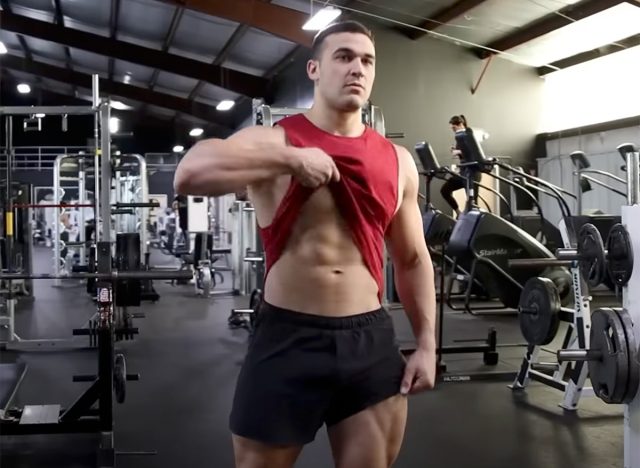
"If you're looking to pack on dense muscle tissue and add quality mass to your frame, you need to follow specific dietary guidelines. These guidelines include consuming enough high-quality protein, eating the right calories to optimize muscle growth without excess fat gain, and eating nutrient-dense food to stay healthy," he says in the video.
These 10 Foods Check the Boxes
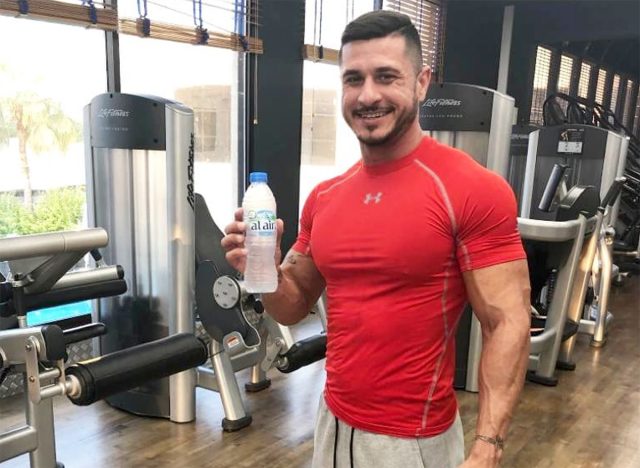
"To make following these guidelines easy, there are specific foods every man should consider including in their diet. To be clear, these are not superfoods, and there's nothing magical about them. However, they do an excellent job of checking the boxes we mentioned earlier, being high protein, having a good amount of volume for their caloric value, and being nutrient-dense," he says. "These will be top-quality foods lifters have been eating for centuries to level up their gains."
Whey or Vegan Protein Powder
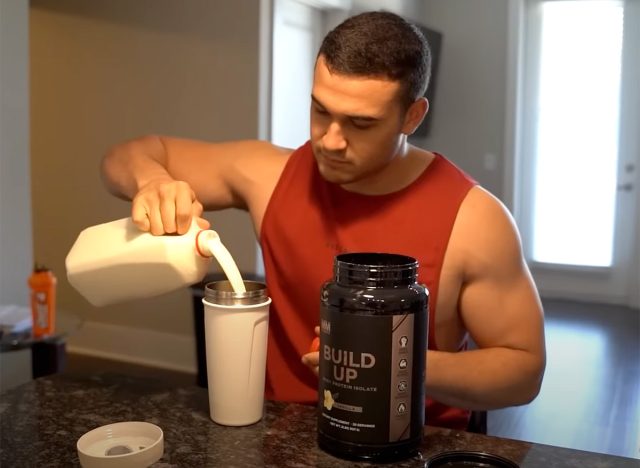
Number one, whey or vegan protein powder. "Some of you may be thinking protein powder isn't a food, but keep in mind that these protein powders are derived from natural foods like milk, soy, or pea, depending on which supplement you choose," he says. "One of the biggest struggles most lifters have in the fast-paced society we live in today is consistently eating enough protein from whole foods, and the key word is consistent, meaning it's measured, tracked, and more often than not, hitting the protein goal recommended." He notes that the average 220-pound lifter would need 176 grams of protein divided into four meals, which is 45 grams of protein per meal. "So unless you have large amounts of protein at each meal, which can also be expensive, two scoops of protein are convenient for you to up your protein intake," he says.
Eggs
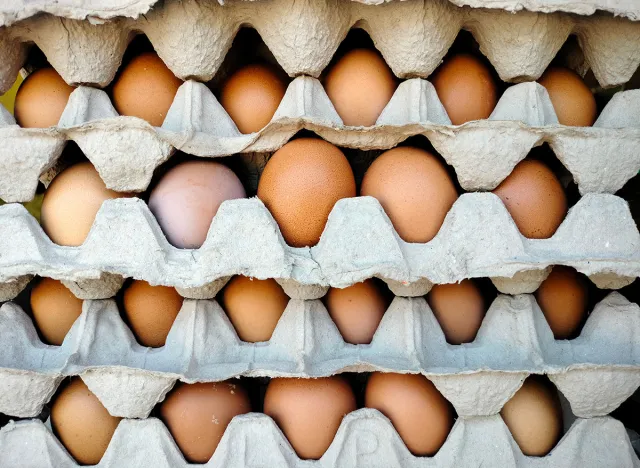
Number two, eggs and egg whites. "Whole eggs have one of the lowest costs to nutrient density of all foods, meaning you pay a lot less for the amount of protein and healthy nutrients in an egg than many other foods," he points out. "The yolk also contains healthy fats which help support testosterone levels and natural lifters. Another significant benefit of eggs is that you can separate the yolk from the whites. Contrary to popular belief, protein is contained in both the yolk and the white, but the white is more concentrated with protein. So if you're looking to reduce total calorie intake but need to keep protein intake high, you have the option of consuming more of the white than the yolk."
Oatmeal

Number three is oatmeal. "If you've heard that carbohydrates are bad for you or make you fat, just know that it's fake news. Bodybuilders who engage in high-intensity lifting tap into their glycogen stores for energy. Glycogen is stored in the liver and in muscles themselves to a minor degree. If you are carb adapted, which means your body is used to converting carbs for fuel, which most people are, your body will convert carbs as your fuel source," he explains. "Oats are a great source of fiber and nutrients like manganese, phosphorus, magnesium, copper, iron, zinc, and vitamin B. They're also fast to make satiating and mixed with protein powder, making them a well-rounded muscle-building meal."
RELATED: 20 Superfoods for People Over 50
Turkey Breast
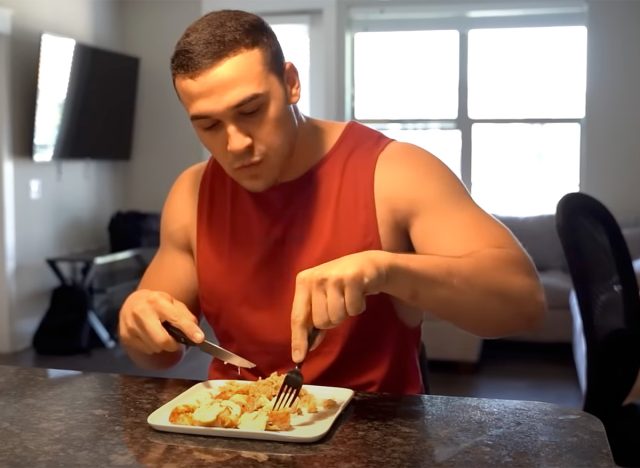
Number four, Turkey breast. "Turkey breast is next on the list because it's one of the leanest protein sources on the planet," he reveals. "Let's compare Turkey breast to a few other types of meat. 100 grams of Turkey breast has 30.1 grams of protein. At 135 calories, it has zero carbs and only 0.7 grams of fat. That is practically all protein. Chicken breast, which is almost every bodybuilder's go-to meat, has 23.1 grams of protein, zero carbs, and 1.2 grams of fat with a total calories of 110. As you can see at the same amount, Turkey breast is an even leaner source of protein than chicken breast. The difference is even more significant with fattier meats like ground beef and steak. So if you're on a cut or want to reserve calories for other carbs and fats you enjoy having in your diet, including Turkey breast in your diet is a great choice."
Lentils and Legumes
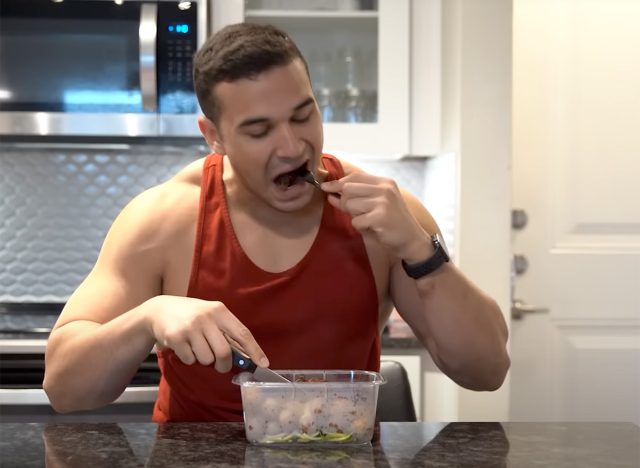
Number five, lentils and other legumes. "This isn't only for our plant-based lifters," he says. "If you want a way to increase your protein intake while adding healthy fiber, consider swapping some of your carbs like rice and bread for lentils," he recommends. "100 grams of cooked rice contains 28.2 carbs in 2.7 grams of protein. On the other hand, 100 grams of lentils have 20.1 grams of carbs and nine grams of protein. Also, lentils contain six more grams of fiber than rice, so plant-based lifters are likely to consume lentils in their diet for their protein content and other high-protein foods like tofu. Consider swapping your carb-based food for lentils if you need more fiber or just want more variety."
Sweet Potatoes
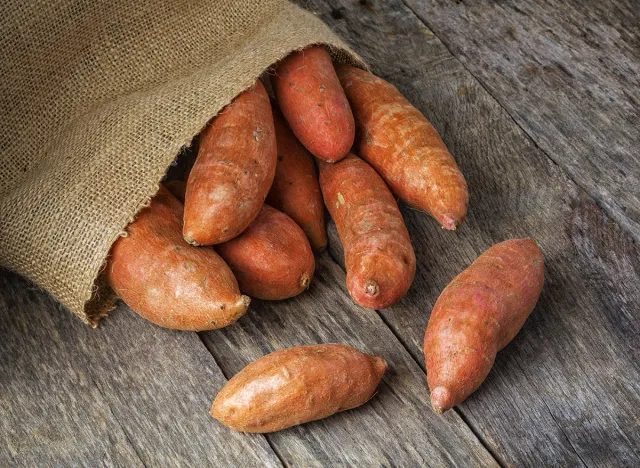
Number six, sweet potato. "Next on the list of foods, every man should eat sweet potatoes," he says. "Like all potatoes, sweet potatoes are voluminous, meaning there's a lot of food content for the number of calories they contain. The opposite would be calorie-dense, meaning there are many calories in a small amount of food. This is the case with many desserts where only a few bites can have hundreds of calories. Sweet potatoes, as a natural whole food, also have antioxidant properties. However, 100 grams of sweet potatoes contains 90 calories and 20 grams of carbs. If you enjoy french fries, cutting these up and baking them in a pan or putting them in an air fryer is a similar but much healthier alternative if you're short on time. Sweet potatoes are also great to make in bulk and have them as a side throughout the week as part of your meal prep."
RELATED: This Plan Is How to Lose 5 Percent Body Fat In 2 Weeks
Greek Yogurt
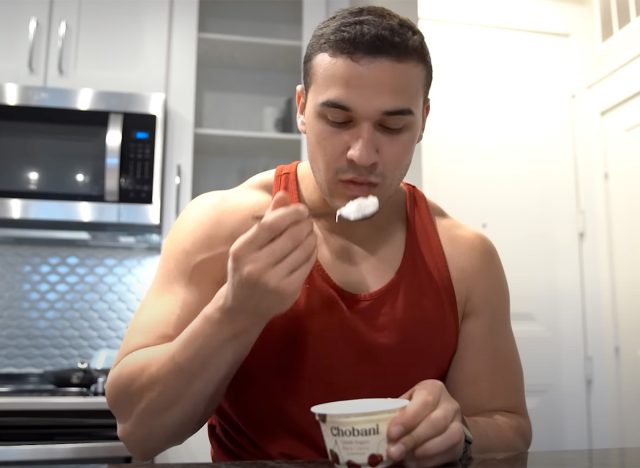
Number seven is Greek yogurt "for its high protein content and because you can spice it up in so many ways," he says. "Of course, we'd recommend the reduced sugar option. 100 grams of Greek yogurt contains 10.6 grams of protein and only 2.8 grams of carbs. A nice bowl of Greek yogurt is around 200 grams and gives you 21 grams of protein." He recommends flavoring with cinnamon honey, blackberries, strawberries, and bananas. "This is an excellent snack between meals or before a morning workout when you don't want to overeat. Have you ever tried mixing your favorite protein powder with Greek yogurt? Not only does it add protein, but it gives it a pudding-like texture that you can eat directly or put on top of a rice cake with berries," he says.
Spinach
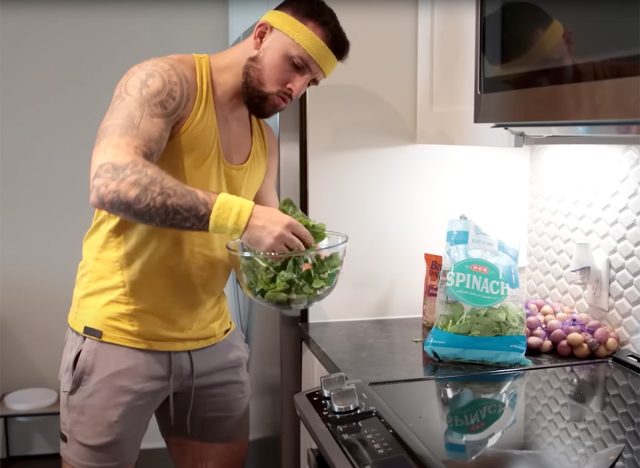
Number eight, spinach. While "there isn't research showing that spinach directly helps your gains," he notes other health and recovery benefits. "This 2014 study discusses the antioxidative benefits of spinach on exercise-induced oxidative stress and muscle damage. Spinach is loaded with nutrients and is ultra low in calories. If you want to be in the iron game for a long time, staying healthy and having high energy needs to be on the top of your list, along with lifting and eating enough protein."
Avocado

Number nine is avocado, which helps you "maintain healthy hormone levels to build muscles," he says. "It's essential to keep your healthy fats up, and that's why we're adding avocados to the list," he says, citing a 2004 study examining the relationship between dietary intake and anabolic hormone concentrations of testosterone. "Free testosterone and growth hormone subjects were examined at rest and after the heavy resistance exercise in eight strength athletes and 10 physically active non-athletes. The results suggested the possible role of diet leading to alterations in serum testosterone and free testosterone during prolonged strength training and that diets with low fat or excessive protein may compromise the anabolic hormonal environment over a training program. Other healthy fats like oils, fish, and nuts play a role in naturally supporting testosterone levels, and lifters ensure that at least 20% of your calories come from good fats to keep your testosterone levels at a healthy level."
RELATED: I Ate 3.5 Ounce of Protein Every Day, and Here Is Why
Beef Jerky
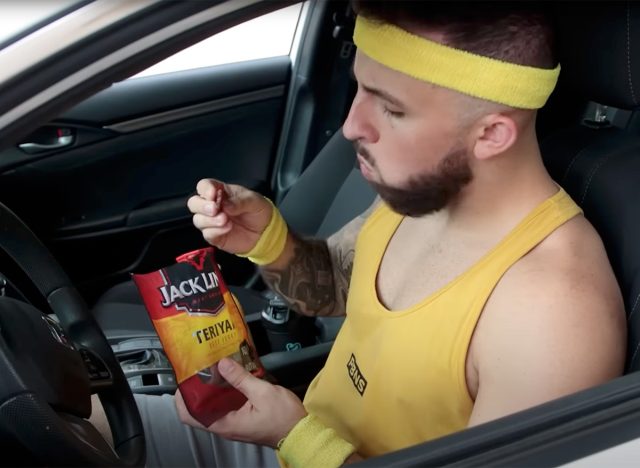
And last, beef jerky. "Let's be honest, a big part of the reason people slip up on their diet is that they don't have convenient access to healthy food all the time, so they end up going through an easy fast food drive-through window to get something quick. So, what do you do when healthy foods aren't an option? Here's our suggestion: Next time you pull over for gas, grab some beef jerky. If you're on the road, you'll quickly hit 30 to 40 grams of protein with a large enough pack, and you can get simple carbs from a fruit drink like orange juice," he says. And if you enjoyed this article, take advantage of these 15 Quick Ways to Lose Body Fat Percentage in a Week.





